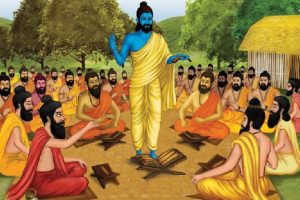 Yajurveda (700-300 BC) has been dealt with in a treatise called Hindu World where it is described as the second Veda, compiled mainly from Rig-vedic hymns, but showing considerable deviation from the original Rig-vedic text. It also has prose passages of a later date. The Yajur-veda, like the Sama-veda samhita (collection), introduces a geographical milieu different from that of the Rig-veda. It is not so much the Indus and its tributaries any more, but the areas of the Satlej, Jamna and Ganges rivers.
Yajurveda (700-300 BC) has been dealt with in a treatise called Hindu World where it is described as the second Veda, compiled mainly from Rig-vedic hymns, but showing considerable deviation from the original Rig-vedic text. It also has prose passages of a later date. The Yajur-veda, like the Sama-veda samhita (collection), introduces a geographical milieu different from that of the Rig-veda. It is not so much the Indus and its tributaries any more, but the areas of the Satlej, Jamna and Ganges rivers.
The Yajur-veda represents a transition between the spontaneous, free-worshipping period of the Rig-veda and the later brahmanical period when ritualism had become firmly established. It is a priestly handbook, arranged in liturgical form for the performance of sacrifices (yaja), as its name implies. It embodies the sacrificial formulas in their entirety, prescribes rules for the construction of altars, for the new and full-moon sacrifices, the rajasuya, the asvamedha, and the soma sacrifices. Strict observance of the ceremonial in every detail was insisted upon, and deviations led to the formation of new schools, there being over one hundred Yajur-vedic schools at the time of Patanjali (200 BC). Much of the sakha literature grew up out of variants of the Yajur-vedic texts.
In the Yajur-veda the sacrifice becomes so important that even the gods are compelled to do the will of the brahimns. Religion becomes a mechanical ritual in which crowds of priests conduct vast and complicated ceremonies whose effects are believed to be felt in the farthermost heavens. Its under-lying principles were so ridden with superstition and belief in the power of the priests to do and undo the cosmic order itself that critics have likened their formulas to the ravings of mental delirium. The priest especially associated with the Yajur-vedic ceremonial was the adhvaryu.
The Yajur-veda now consists of two samhitas, which once existed in one hundred and one recensions. Both the samhitas contain almost the same subject matter but differently arranged. The Taittiriya Samhita, commonly called the Black Yajur-veda for its obscurity of meaning, was known in the third century BC, and is the older of the two. It has been described as an ‘undigested jumble of different pieces’, and as having ‘a motley character’. In this samhita the distinction between the Mantra and the Brahmana portions is not as clear as in the other Vedas.
The Vajasaneyi Samhita, or the White Yajur-veda, was communicated to the sage Yajasaneti Samhita by the Sun God in his equine form. It has a much more methodical arrangement and brings order and light, as opposed to the confusion and darkness of the Black Yajur-veda. In the book titled Sacred Scriptures of India it says that Yajurveda inspires humans to walk on the path of Karma and that is why it is also referred to as Karma-Veda. The essence of the Yajurveda lies in those mantras (incantations) that inspire people to initiate action. It further says that there are many branches of Yajurveda but two branches, namely, Krishna and Shukla Yajurveda have gained relatively more prominence, i.e., Krishna Yajurveda and Shukla Yajurveda. Besides it, it says that Yajurveda was later on named as “Taitareya Samhita”.
Sama-veda (c. 700-300 BC) (saman, ‘melody’), the third Veda. Its samhita or principal part is wholly metrical, consisting of 1549 verses, of which only 75 are not traceable to the Rig-veda. The stanzas are arranged in two books or collections of verses. The Sama-veda embodies the knowledge of melodies and chants. The samhita of this Veda served as a textbook for the priests who officiated at the Soma sacrifices. It indicates the ‘tunes’ to which the sacred hymns are to be sung, by showing the prolongation, the repetition and interpolation of syllables required in the singing. The Sama-veda also contains a detailed account of the soma rites. The hierophants associated with the Sama-veda are known as the udgatri.
Many of the invocations in the Sama-veda are addressed to Soma, some to Agni and some to Indra. The mantra part of the Sama-veda is poor in literary quality and historical interest, but the Brahmanas belonging to it are important. Of the once numerous samhitas of the Samaveda (the Puranas speak of a thousand) only one has reached us, in three recensions, namely: the Kauthama, current in Gujarat, the Ranayaniya which survives in Maharashtra, and the Jaiminiya in the Karnatic.
In the Sacred Scriptures of India it is described that the compilation of Richas (Shlokas) is known as Sama. Sama is dependent on the Richas. The beauty of speech lied in the Richas. The beauty of Richas lie in the sama and the beauty of the same lies in the style of pronunciation and singing. The knowledge of sama, therefore, is Samaveda. This refers to Geeta-10/22 where Shri Krishna has stated the importance of Samaveda in the following manner: Vedamana Samavedo Asmi meaning “I am samaveda myself amongst the Vedas.”
There are two parts of the Samaveda (1) Purvarchik (2) Uttararchik. In between both of them is ‘Mahanamnayarchik which comprises of 10 incantations. There are four parts of Purvarchika Aagneya, Aendra, Paavmaan and Aasanya.
Atharvaveda is considered in Hindu World as the fourth Veda, of whose origin there has been much contentious speculation. It is also referred to as the Brahma-veda because it served as the manual of the chief sacrificial priests, the brahmins. A great deal is said in the Atharva-veda hymns about the brahmins and the honours due to them. One-sixth of the work is not metrical, and about one-six of the hymns are also found among the hymns of the Rig-veda, mostly in the first, eight and tenth books. The rest of the subject matter is peculiar to the Atharva-veda, This Veda was once current in nine different redactions, of which only two, the Pippalada and Sunaka recensions are extant, the former in a single unpublished ‘Tubingen manuscript’ discovered by Roth.
The Atharva-veda embodies the magical formulary of ancient India, and much of it is devoted to spells, incantations, chants and charms. In general the charms and spells are divided into two classes; they are either bheshajani, which are of medicinal, healing and peaceful nature, dealing with cures and herbs for treating fever, leprosy, jaundice, dropsy and other diseases; this class includes prayers for successful childbirth, love spells, charms for fecundity, for the recovery of virility, hymns for the birth of sons, and a quaint chant to put the household to sleep while the lover steals into the girl’s home at night. Or else they belong to the abhichara class, which are of a bewitching and malevolent nature; these include spells for producing diseases and bringing ill-luck to enemies. Among them is a spell that a woman may use against her rival to make her remain a spinster; another spell is meant to destroy a man’s virility, and so forth. There are hymns to serpents and demons, and incantations replete with witchcraft, sorcery and black magic.
 One of the reputed authors of the Atharva-veda was the Rishi Atharvan, of Maga of Persian ancestry. But certain parts, especially the verses dealing with the rites of sorcerers and wizards were attributed to the Rishi Angiras, of pre-Aryan, probably Dravidian stock. The hymns were said to have been collected by Sumantu, a Rishi of great antiquity who bequeathed the material to Rishi Vyasa for arranging.
One of the reputed authors of the Atharva-veda was the Rishi Atharvan, of Maga of Persian ancestry. But certain parts, especially the verses dealing with the rites of sorcerers and wizards were attributed to the Rishi Angiras, of pre-Aryan, probably Dravidian stock. The hymns were said to have been collected by Sumantu, a Rishi of great antiquity who bequeathed the material to Rishi Vyasa for arranging.
The Atharva-veda is the most interesting of the sruti, for it has preserved to a great extent a solid core of pre-Aryan and non-Aryan tradition. It is unique among the texts of Vedic period and ‘an important source of information regarding popular religious belief, not so far modified by priestly religion.’ It reveals in fact a vast substratum of indigenous doctrine that is not only non-Vedic but at times contra-Vedic.
Scholars trace Mesopotamian influences in the Atharva-veda, among them Dr. Bhandarkar, who discerns in it the magical lore of the Asuras. Others see evidence of Vratya and Maga Doctrines. The Vishnu Purana and the Bhavishya Purana speak of the Angiras as one of the four Vedas of the Magas. The foreign words occurring in the Atharva-veda, which Tilak traced to Chaldea, may have been only strange to Sanskrit, and may well have formed part of the regular vocabulary of the Maga priests.
For long the Atharva-veda was not included among the other three Vedas. Although the Vedas are now said to be four in number this was not the originally recognized number of the compilations. The oldest records refer to only three Vedas, namely, the Rig, Sama and Yajur. Manu speaks of these as the trayi (triad) milked out from the fire, air, and sun, and the Atharva-veda was not even acknowledged in his time. There is no reference to it in the Chhandogya Upanishad; the Brahmana texts mention only three Vedas; the Jatakas know of only three.
This would seem to indicate not that the Atharvaveda was non-existent at the time the other Vedas were composed, but that it did not for several centuries form part of the sacred scriptures of the Aryans. Of its canonical status today it has been said that ‘influential scholars of South India still deny the genuineness of the Atharva-veda’. While discussing this Veda in the treatise titled the Sacred Scriptures of India, this Veda is described as devoid of movement or concentration. The word Tharva means fickleness or movement and accordingly the word “Atharva” means that which is unwavering, concentrated or unchanging. That is why it is said: Tharva Gati Karma Na Tharva Eti Atharva.
The philosophy of Yoga speaks that: Yogash Chitta Vritti Nirodhah, which means controlling the different impulses of the mind and senses in Yoga. The Gita re-iterates that when the mind is free from impulses and flaws, the mind becomes stable and the person becomes neutral when the impulses of the mind and the other senses are in control, then only the mind is freed from instability and perturbances. The word “Atharva” therefore refers to neutrality of personality. The Atharvaveda speaks more about Yoga, the human physiology, different ailments, social structure, spirituality, appreciation of natural beauty, national religion, etc. This knowledge is practical and is worth bringing in use. This Veda is a fusion of prose and poetry together. Ayurveda is considered to be the Upaveda (Sub-Veda) of this Veda. This write up highlights the spiritual aspects of Vedas only. The other little known aspects shall be discussed later.
Next issue: Puranas, the eternal trouble shooters
letters@tehelka.com












